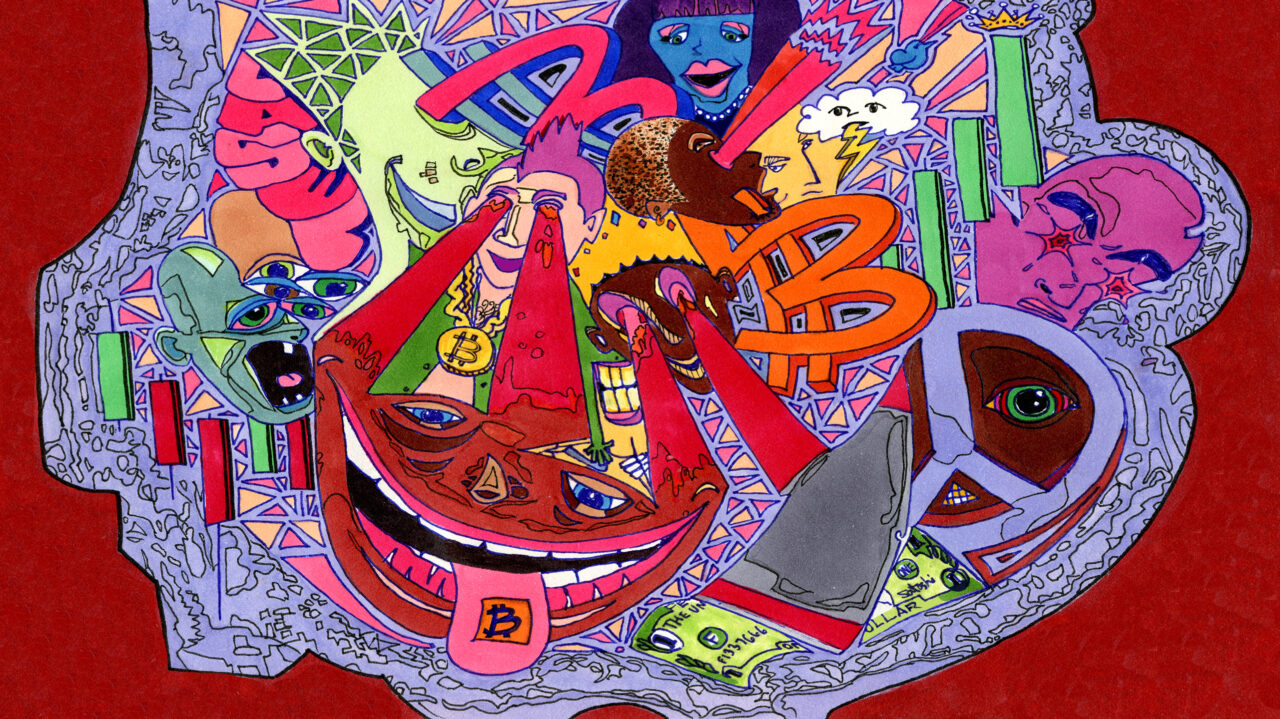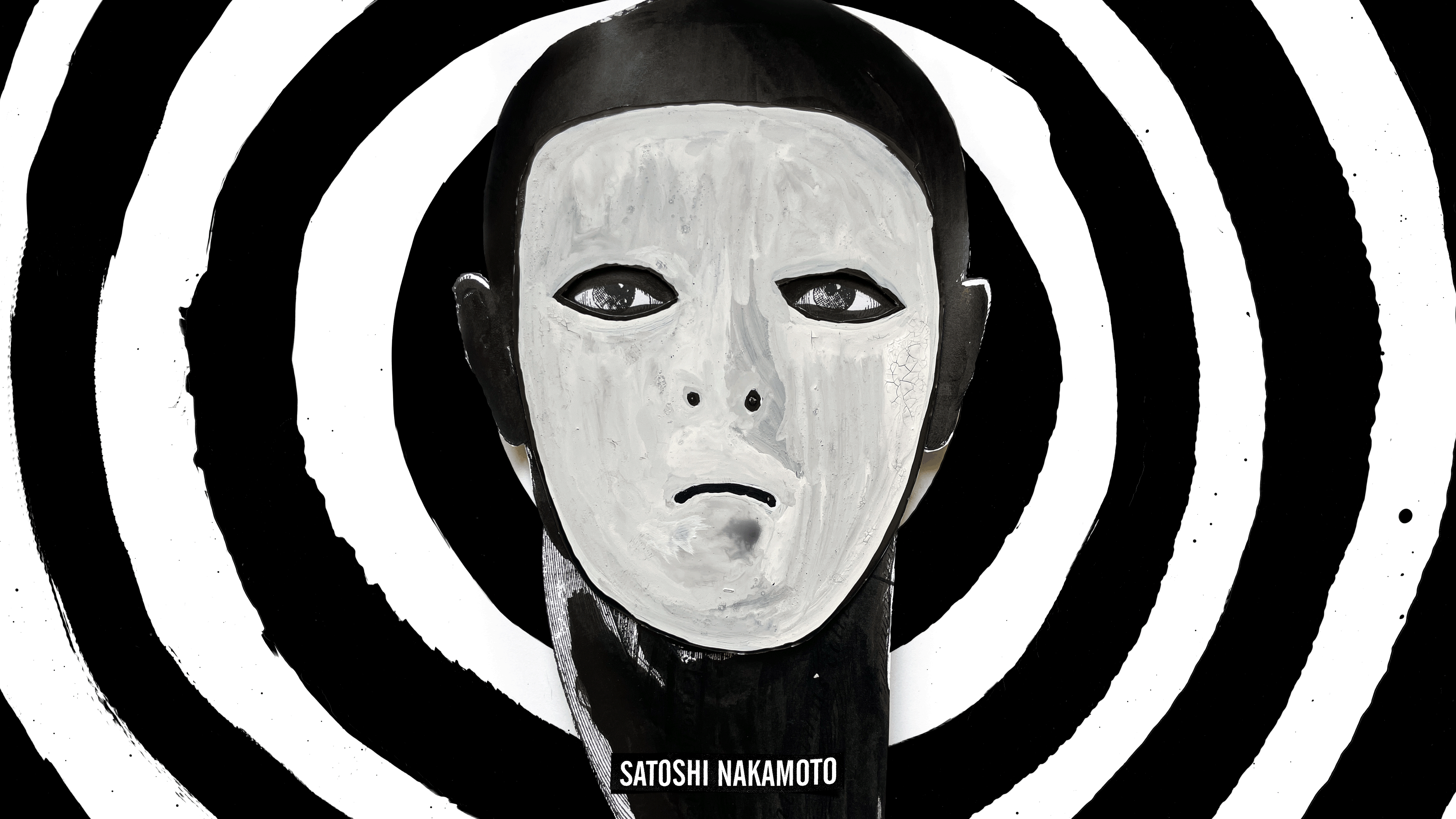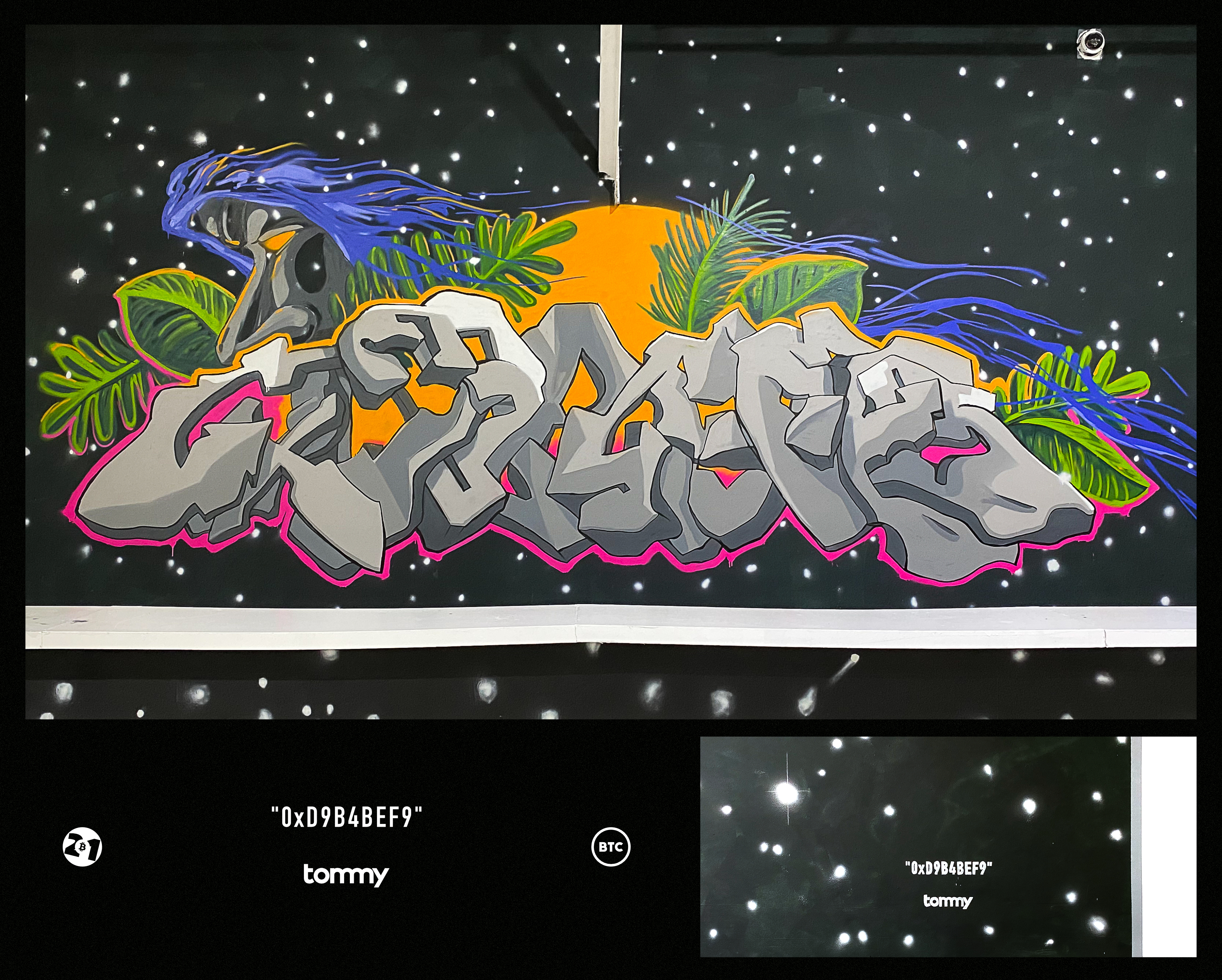About The Artist
There are few topics more controversial in the bitcoin art community than using Non-Fungible Tokens (NFTs).
Even within the 21ism team there are polarised views on the use of digital tokens in art, with some hating them and some loving them. So what is going on? Where did the fallout begin and what can be done to make NFTs more palatable for Bitcoiners? What is Raretoshi and why is it important?
This block I take a break from showcasing a single artist’s work and try to answer the quandary on most bitcoin art lovers lips:
“To NFT, or not to NFT? That is the question”
WTF is NFT
Let’s begin with what an NFT is. In economics, a fungible asset is something with units that can be readily interchanged – like bitcoin. If you swap a 1000 satoshis for another 1000 satoshis they will have the same value. But if something is non-fungible, this is impossible. It means it has unique properties so it cannot be interchanged with something else.
A great example of this is Leonardo Da Vinci’s masterpiece, the Mona Lisa, which is one of a kind. You could reproduce the painting by taking a photo of it or buying a print, but there will only ever be one original painting. NFTs are “one-of-a-kind” digital assets on a blockchain that can be bought and sold like any other piece of property, but they have no tangible form of their own. These digital tokens can be thought of as certificates of ownership for virtual or physical assets.
"Provenance is a big piece of all this. That’s where NFTs are coming into play."
The benefits of digital proof of ownership and art mean that ownership can be transferred directly in a digital format from artist to buyer in an immediate borderless manner. Speaking from personal experience and that of fellow 21ism artist Max BitBuyBit, this is incredibly useful, as both of us have had our art stopped, seized and delayed at customs.
Tokenising also gives buyers clear provenance of the piece, giving assurance that they are purchasing an original and supporting the creator. No more guessing if a piece is real, investigative art TV shows like ‘Fake or Fortune?’ or shady antiquated estates having the final centralised say if it was painted by the hand of a renaissance master.
Assurance is one of the main reasons that Tommy, artist and Bitcoin Magazine Art Director decided to provide NFTs with purchases of physical limited edition Tony Hawk signed skateboards at the Bitcoin 2021 conference “Provenance is a big piece of all this. That’s where NFTs are coming into play. You’re buying the skateboard, you’re not buying the NFT, the NFT just comes with it as a certificate of authenticity. Transferring it from the correct owner to correct owner will have a documentation or ledger of transactions that shows where this where the skateboard has been.”
Unlike the traditional art auction gallery model, selling fees for artists are much lower on many digital marketplaces. Many also offer a cut of secondary sales to the artist through their platforms, giving much needed income to help creators continue to produce and hone their craft.
So far so good. NFT sounds like a technology that can improve the distribution of art. So where does this NFT hate come from in the bitcoin community?
The Eth in the room
The first point is that a lot of NFTs are minted on every Bitcoiner’s favourite blockchain – Ethereum. With no hard cap on issuance and a move fast and break things approach, it goes against the principles laid out in Satoshi’s white paper. As a consequence, it hasn’t found much love amongst Bitcoin plebs to put it very politely. However, Ethereum wasn’t always the coin of choice to mint your NFTs. It actually started on Bitcoin as OG artist DJ Scrilla explains “We started making [NFTs] on the Bitcoin blockchain with XCP (Counterparty) at first, then the market kind of disappeared after the Ethereum VCs basically got everybody over onto the Ethereum chain.”
"There’s high prices just for minting the work [on Ethereum]."
With a combination of Bitcoin’s function perceived as ‘just a monetary network’ and the huge amount of private investment dollars pouring into Ethereum, Vitalik’s coin snatched the crown from Bitcoin and dominated the NFT landscape. History is written by the victor as they say, and the narrative shifted to Ethereum being the birthplace of Cryptoart. In the recent sale of Beeple’s Everydays: The First 5000 days for $69 million at auction house Christies, OG artist Cryptograffiti recounts being in an official Clubhouse room discussing the sale:
“Christie’s people were running the room just breezed right over the fact that this lady actually said that it started with ERC 20 tokens (Ethereum). I took offence to that because they should have known better and it seemed like an opportunistic situation. I think it’s important that we remember and give praise to the people that were the true pioneers.”
Ethereum is failing on a functional level too. Its network is clogged with transactions and as a consequence has infamous high transaction fees. The result is buyers being put off acquiring works, and artists using less secure, cheaper blockchains that have little to no chance of long term survival as Cryptograffiti explains:
“There’s high prices just for minting the work, and there’s new chains that are coming along. The prices are lower, and it causes some confusion and raises questions like what are these new chains all about? Should I even be trusting them putting my work on these third parties that may not even be around?”
Money digital, Art physical
The second major issue of lack of NFT adoption in the pleb art community is that Bitcoiners are sceptical of any digital asset that is not Bitcoin. This is summed up succinctly by resident 21ism memer Self Bankt – “I like my money digital and art physical”.
It does seem odd, and almost contradictory that Bitcoiners who are leading a digital scarce borderless currency revolution would largely eschew purchasing digital scarce borderless art. Tommy has his own theory on the scepticism: “I think bitcoiners are purists and they understand the value of physical art and the scarcity in a physical piece.”
"Everything I buy is going to be in my hand."
It’s not just the collectors that are not sold on digital NFT pieces, Bitcoin artist MVDEX (pronounced Made X) is keen on keeping his art physical. “If somebody wants the uncertainty of sitting on a JPEG for many years, they’re welcome to do that. Everything I buy is going to be in my hand.” Interestingly MVDEX has created a novel way to verify his art, keep it tactile but still interact with Bitcoin blockchain. Drawing inspiration from the legendary Casacius physical bitcoins, he seals an Opendime loaded with bitcoin of a known wallet to the back of each of his canvases. This innovative solution works well for his art, but wouldn’t necessarily work in all artforms or digital pieces.
What this does highlight however is that artists would go to great lengths to tie their work to the Bitcoin network. And why not? As Scrilla says “I want my art to live on forever. In my opinion, Bitcoin is the only thing that is going to live on forever.”
The Solution
If only there was a marketplace that is able to mint, auction and trade NFTs associated with digital and physical pieces of art tied to the Bitcoin network?
Well, we need to wonder no longer my fellow art plebs.
Enter Raretoshi – an open source project created by Adam Soltys (CTO of Coinos), Cryptograffiti and Blockstream.
"Raretoshi has the potential to turn all art fans and collectors into dormant Bitcoiners."
This month, I sat down with Samson Mow, Chief Strategy Officer of Blockstream, hat lord and Bitcoin art fantastic to talk to him about this exciting new project that has the potential to revolutionise the Cryptoart landscape.
Raretoshi is built on the Liquid Network. Not being the most technically literate pleb, I am always sceptical when a network other than Bitcoin is mentioned. Samson however quickly put my mind at ease. “Liquid is a Bitcoin side chain. Its own blockchain but without a native currency. Typically, when someone launches a new chain, there is a native token in the ICO and it’s kind of scammy in general. The currency of liquid is Bitcoin, you peg it in Bitcoin to the network.”
By using Liquid, Raretoshi maintains many of the properties of the underlying Bitcoin base chain but includes benefits that make it a functional and competitive NFT marketplace. “The cost of a liquid transaction is 10 cents or less, or at least right now with the current Bitcoin prices. The transactions are fast too. It’s just a really efficient way to create your art, mint it and then trade it so people can support the artists that they like.”
ART COLLECTION
Bitcoin only
Not only is the underlying mechanics pegging to Bitcoin but so are the pieces on Raretoshi. All artists are curated to ensure quality Bitcoin related artwork. You won’t find any NFTs “ripping artwork off of Google and minting it” as Samson puts it. Just incredible works by key artists in the space such as, DJ Scrilla, Eppo Lemburg, Cryptograffiti and CypherPunkNow to mention a few.
"[Raretoshi] is a really efficient way to create your art, mint it and then trade it so people can support the artists that they like."
It is also reassuring to know that any NFT trades made between sellers on the website also give a percentage back to further support artists: “It’s done through something similar to block stream app. It’s basically a multisig policy server. So, as an artist that selling your artwork, you can say I want 20% cut of future sales, and the server will enforce that.”
To the moon and beyond
Whilst it is a functional product, you do get the feeling that Raretoshi is far from hitting its full potential. What future plans are there for Raretoshi? “We’re investing more to improve the user experience.” Samson says. “Make things smoother, more accessible. And I think, down the road, we need to support these NFTs in some of our liquid enabled wallets like Blockstream Green, and Aqua.”
Knowing that Samson is working on a separate epic 3D space MMORPG game, Infinite Fleet, I wanted to know if there was a possibility of a virtual Bitcoin art gallery in the upcoming game? Will Bitcoin art not just go to the moon but to another galaxy completely? “If there is demand for something like that, we could probably, you know, figure something out. If you come to Raretoshi, and you’re an artist, perhaps you could do an exhibition in VR. And it could be this worldwide event.”
NFT Bitcoinisation
Whether we Bitcoiners like them or not, the NFT market is booming with over $2.1 Billion in sales in the first half of 2021. As Ethereum fees skyrocket and as we adopt more digital assets in our lives, it becomes clear that at some point that NFTs will make a jump to a network that is the most secure. We all know that network is Bitcoin.
"I want my art to live on forever. In my opinion, Bitcoin is the only thing that is going to live on forever."
The advent of Raretoshi is a defining moment as we now have an open source user-friendly system that is capable of minting, auctioning and trading NFTs associated with digital and physical pieces of art tied to the Bitcoin network. Perhaps even more importantly, the team behind Raretoshi are a bunch of Bitcoin artists and plebs who have the best interests of Bitcoin culture at heart.
Cryptograffiti said to me in an interview that “all artists are Bitcoiners, they just don’t know it yet”. By the same score, Raretoshi has the potential to turn all art fans and collectors into dormant Bitcoiners. Not only would this be huge for the future adoption of bitcoin as a currency, but also help proliferate the culture of the orange coin we hold dear.



